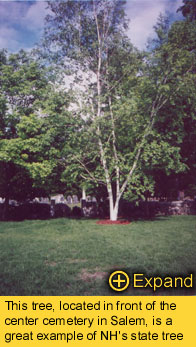 This year was Salem New Hampshireís 250th birthday celebration. Though
itís not as old as some towns, and doesnít have a dramatic history, it
still remains a town that has evolved from one church as a town hall, and
a small group of Methuenites, to encompass nearly 28,000 people, and 25.6
square miles of land. A lot of growth has occurred, not only in population
and size, but in industry, tourism, religion, and other important areas.
This, my friends, begins your guided tour through the excitement, wonder,
and intrigue of the history of Salem, New Hampshire....
This year was Salem New Hampshireís 250th birthday celebration. Though
itís not as old as some towns, and doesnít have a dramatic history, it
still remains a town that has evolved from one church as a town hall, and
a small group of Methuenites, to encompass nearly 28,000 people, and 25.6
square miles of land. A lot of growth has occurred, not only in population
and size, but in industry, tourism, religion, and other important areas.
This, my friends, begins your guided tour through the excitement, wonder,
and intrigue of the history of Salem, New Hampshire....
During the 1600ís, much
of what is now Salem, Methuen, Atkinson, Hampstead, and Plaistow, were
part of Haverhill. Much of the population was Puritan, and religious and
governmental life was centered around the Puritan Meeting house in Haverhill.
Methuen broke off and got General Court permission to form their own church
in 1725. The new district that was formed contained a large part of Salem,
and the parish was located nearby Holy Family Hospital, today. A mere thirteen
years later, Salem asked to become the North Parish of Methuen, and built
a meetinghouse at Salem Center, which was built starting in November, 1738.
To make accommodation for the newly formed town to grow, and be easily
accessible, a road was laid between Salem Center to Salem Depot. In later
days, this road would serve as a main road, studded with shops and farms.

The building of the
meetinghouse was a relief for the new Salem citizens. They had been paying
a ministerís tax to the church in Methuen, which they were seeing no part
of. Methuen was too far away for most residents to travel too. Salemís
meetinghouse was conveniently placed.
In 1741, the boundary
lines between New Hampshire and Massachusetts were formed, and the Northern
Parish of Methuen was located in New Hampshire. Salem was officially chartered
as a town in 1750. In order to make it easier to travel within the new
town, North Main ST. was laid out. The First Congregational Church, Salemís
first church, was located in the meetinghouse until 1840, when it was rebuilt
on Lawrence Road. Schools in Salem were held in private homes during the
winters, for one to two months. In 1759, four school teachers were hired,
one for each section of town. Actual school houses were built in the early
1800ís, and tax refunds were given to those who donated goods.
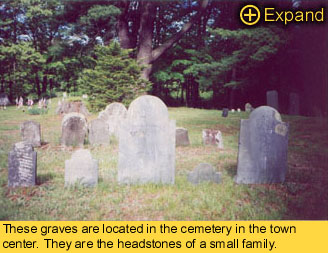 In 1866, Salemís first large manufacturing factory was built. T.M. Russ
Factory was one of Salemís shoe manufacturing plants. It, along with, eventually,
six other shoe factories, helped to make Salem New Hampshireís sixth largest
shoe producer. After being a shoe manufacturer, the Russ Factory became
the home for Robbins Transportation Company, who were egg suppliers for
First National Stores all over New England.
In 1866, Salemís first large manufacturing factory was built. T.M. Russ
Factory was one of Salemís shoe manufacturing plants. It, along with, eventually,
six other shoe factories, helped to make Salem New Hampshireís sixth largest
shoe producer. After being a shoe manufacturer, the Russ Factory became
the home for Robbins Transportation Company, who were egg suppliers for
First National Stores all over New England.
Another part of industry
at the time was in North Salem, which had many mills, producing everything
from shingles and shoes to matches and flannel, and creating many jobs.
Most of the power for these mills was provided by water from the Spicket
River. Taylorís Mill, which was unfortunately destroyed in 1878, was at
one point the largest woolen mill in Salem, and was employing close to
one hundred people.
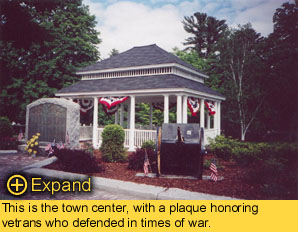 The introduction of the Manchester & Lawrence Railroad in 1887 greatly
changed the town. Before itís arrival, most of Salemís businesses were
located around Center and North Salem St. When the M&L railroad was
built, the area that had been almost entirely farmland became more populated
by businesses. This train crossing became Salem Depot, and slowly became
the new "hub" of town.
The introduction of the Manchester & Lawrence Railroad in 1887 greatly
changed the town. Before itís arrival, most of Salemís businesses were
located around Center and North Salem St. When the M&L railroad was
built, the area that had been almost entirely farmland became more populated
by businesses. This train crossing became Salem Depot, and slowly became
the new "hub" of town.
Robert Frost, well known
poet and local farmer, earned $24 a month teaching in the No. 9 School
on Lawrence Rd in 1895, after having gone to school No. 6 in 1885. His
mother, Belle Frost, was a teacher there. Robertís sister, Jeanie was also
a student at No. 9. When Robert was a sophomore in high school, his family
moved to Lawrence.
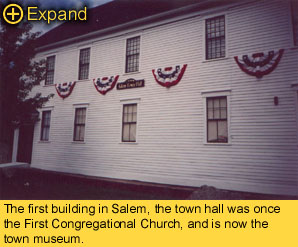 Salem did not have a doctor living in town permanently until, at the request
of a selectman, Dr. Lewis F. Soule came to work here in 1898, right out
of Bowdoin Medical School. He married Jessie Bleakney, who worked as Salemís
school nurse after the Dr.ís death in 1942.
Salem did not have a doctor living in town permanently until, at the request
of a selectman, Dr. Lewis F. Soule came to work here in 1898, right out
of Bowdoin Medical School. He married Jessie Bleakney, who worked as Salemís
school nurse after the Dr.ís death in 1942.
Salem did not have the
health problems of local towns such as Lawrence, due to the fact that there
was a lot of space and fresh air. There was, however, a great deal of intestinal
disease due to poor out houses. Other diseases of problem were pneumonia,
tuberculosis, and diphtheria, common illnesses at the time.
The Rockingham Hotel
was constructed in 1880 on Main and Central Streets. It was a part of one
of the largest commercial blocks in town. In 1906 the hotel was upgraded,
just before the opening of the new Race Track, for the high volume of expected
customers during the racing season. Unfortunately, gambling was permanently
shut down on the second day of racing, keeping the newly built rooms empty.
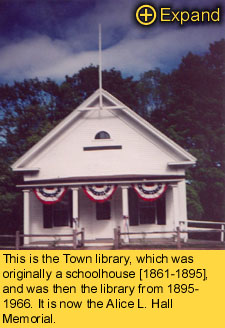 On Monday, September 8th, 1902, the first trolley from the electric railway
system Hudson Pelham and Salem Railway, arrived from Salem to Pelham, Hudson,
and Nashua. This railway system connected Haverhill, Lawrence, Lowell,
Methuen, Dracut, Pelham, Hudson, and Nashua.
On Monday, September 8th, 1902, the first trolley from the electric railway
system Hudson Pelham and Salem Railway, arrived from Salem to Pelham, Hudson,
and Nashua. This railway system connected Haverhill, Lawrence, Lowell,
Methuen, Dracut, Pelham, Hudson, and Nashua.
Hose House 2 was built
in 1906, for a volunteer fire department, after insurance underwriters
said they would reduce insurance rates if a department was built. It was
constructed in an old blacksmith shop and liquor store. This building also
came to be used for Salemís police lockup, municipal offices, and a public
meeting space.
Stanley Stewartís Stanwood
Park was a tea room and dance hall. It was most popular for dancing, and
"most beautiful girl" contests. There were trolley springs under the dance
floor, making it a bouncy place to dance. In the 1920ís, it was quite the
popular place to go.
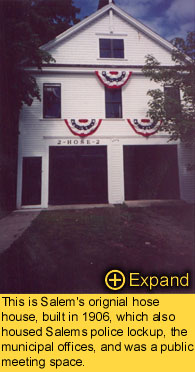 Along with dancing, "church played a large part in most peopleís social
lives. IN addition to still popular suppers and fairs, there were summer
Bible schools and social clubs for teenagers and adults.... Church sports
teams... were popular too."
Along with dancing, "church played a large part in most peopleís social
lives. IN addition to still popular suppers and fairs, there were summer
Bible schools and social clubs for teenagers and adults.... Church sports
teams... were popular too."
In 1925, a dam was built
in Arlington Pond, creating a shoreline called Arlington Park. Many summer
camps were built around this area. During World War Two, it was rumored
that Nazis planned to dynamite this dam.
By the 1930ís, Canobie
Lake was quite the place to be. Besides the station, cottages began to
dot the shores, and Canobie Lake Park was in full swing. Literally. Aside
from the bowling, penny arcades, and walks for lovers, one Canobie Lake
Parkís main attractions was the Canobie Ballroom. Many of the swinging
twenties artists made trips to the Canobie Ballroom, selling tickets cheap.
Duke Ellington, Benny Goodman, Glen Miller, Gene Krupa, Tommy and Jimmy
Dorsey, and Sammy Kaye are just a few of the artists that drew large crowds
of people to the ballroom.
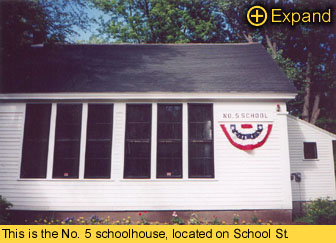
Since then, Canobie
Lake, as well as Salem, have undergone some massive changes. Canobie Lake
Park has now incorporated shows, refreshments, rides, games, and more entertainment
into itís Park. The Canobie Queen, a lake ferry, was brought into use as
a slower, more scenic attraction to Canobie Park.
Salem, like many small
New Hampshire communities, has the challenge in this century to balance
small town quality of life with opportunities for growth. So far, it has
developed into a community of closely knit families, with a strong sense
of community, and a good historical foundation |


